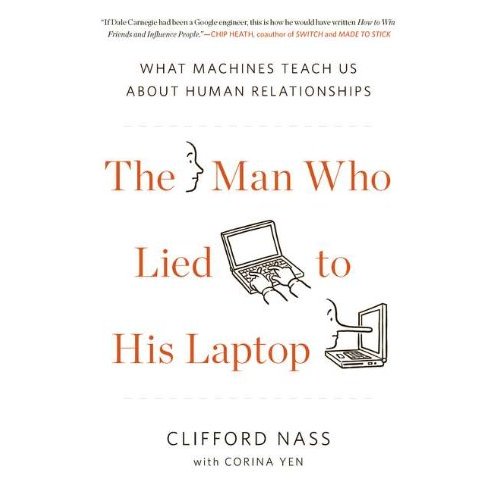


April 2011
In this Issue: Readers' Feedback about Stacking Cups and getting things done.
|
Say
It Quick |
Discoveries bits of serendipity to inspire and motivate |
Ideas fuel for your own continuous learning |
Activities tips and tricks you can try today |
| Reboot | The Truth About Computers | Teaching About Being Human | A Relationship Check |
This month, we'll look at our rapport with computers and what that says about our relationships with each other beginning with this story in exactly 99 words.
Reboot
At five on Friday, Joan's computer went on the fritz. The spreadsheet she
was working on froze. The e-mail browser crashed. Her hand-held device wouldn't
sync. The technical support team had already gone home. There was nothing
else to do so she pulled the plug and left for the weekend.
She returned on Monday anxious about re-entering a feedback loop of computer repair. But when the machine booted up, everything worked fine!
When you've tried everything else, the best solution may be to leave things alone. The trick: knowing when to act quickly and when to walk away.
 The
Truth About Computers
The
Truth About Computers
The Man Who Lied to His Laptop
By Clifford Nass
Computers are supposed to make life easier by taking the routine out of our lives. As this month's 99-Word Story shows, that's not always true. Sometimes they become a source of acute frustration. Yet we cling to them for entertainment, information, communication, and, as Clifford Nass documents in The Man Who Lied to His Laptop even friendship - of a sort.
Nass, who teaches at Stanford University in departments as diverse as communication, computer science, education, sociology, symbolic systems, and technology and science, became interested in the way we interact with our computers. He noticed that people who were asked to evaluate a computer program rated it higher when the questionnaire was administered by their own computer than when administered by a different computer. People could not help being "polite" to their own computer just as they would be polite in evaluating a person they had just worked with.
With this insight, Nass describes nearly fifteen years of his experiments that help identify and define the basics of giving and receiving praise, differences of personality, team building, understanding emotions, and effective persuasion. In all these areas of human interaction, Nass needed to control variables such as tone of voice and emphasis from one research subject to the next. To achieve this, he had his human subjects work with a computer. Surprisingly, people worked as if they were relating to a real person even though they were paired with a machine.
In one experiment, people readily accepted a computer as a valid team member simply because the machine had been designated as being on the "blue" team. All Nass had to do was put a blue border around the monitor with a sign reading "blue computer." Subsequently, blue team members interacted with the machine with more cooperation and effort, greater admiration, more willingness to compromise, and more enjoyment from the activity than did people on the green or orange teams. As Nass points out, if such simple modifications can integrate a non-thinking machine into a team, it shouldn't be too difficult to apply the same principles with people.
This is just one example of the insights about human interactions that Nass has derived by asking people to interface with computers. Here are some other quick learning points from the book:
Perhaps you see nothing new in these insights about human interaction. (Of course people with similar personalities will get along better with each other!) But Nass has learned to measure our reactions to highly complex interactions with a degree of objectivity that has eluded psychologists and social scientists until now. The truth about computers is that they can reveal insights about how our own minds work. By using them to administer tasks that evoke emotion, team work, or praise and criticism, Nass has revealed the binary elements that make human relationships click.
Read the book for the cleverly entertaining experimental strategies Nass employed to learn about these relationships. But you'll come away with gems of insight into how to be more effective in your own social interactions. And when you do, please let me know what you've learned!
The Man Who Lied to His Laptop
By Clifford Nass
Penguin Group, 2010
ISBN 978-1-61723-001-1
Teaching
About Being Human
At first it surprised me that someone would use a machine to help improve
human relationships. I am, by nature, skeptical when we use technology as
a conduit to improve our interactions with other people. Words deliver a message
but a text or a tweet misses most of the emotions which are revealed by tone,
cadence, context, gestures, expressions - and pheromones! Plus with a technological
interface, you can always switch off, unplug, or ignore when your interpersonal
skills are lacking or a conflict ramps up a notch.
In the 99-Word Story, this month, Joan found that disconnecting her technology cleared the system and paved the way for a fresh start. Similarly, the work of Nass clarifies some of our most complex human interactions making it easier to travel the road toward successful relationships. The irony is that he comes to these simple truths about positive interactions between people by employing the most complex technology we have available, the computer.
Like Joan's story, Nass challenges us to make a conscious decision about whether to work harder at making a relationship work or whether to step back, cool off, get perspective, or make a plan. Fortunately, Nass offers specific strategies that are simple and doable. Those straight forward strategies also have the potential to make us less reliant upon our technology and more confident in our own ability to make our relationships more meaningful, productive, and harmonious.
A
Relationship Check
Nass' human subjects actually developed an affinity for the computer they
worked with, even though they knew the machine had no feelings, personality,
or gender. That may sound strange, but it is not surprising. Consider that
we have been talking to our technology for centuries. Sailing ships had names,
a gender, and were even carved with human images at the bow. We coax our cars
when they won't start and curse our computers when they crash. 
Perhaps we do this because we are so dependent on our technology. Or perhaps it is just in our nature to perceive everything from a human perspective. We can't help anthropomorphizing the world around us giving human characteristics to animals (our pets), vehicles (Thomas the Train), and our planet (mountains and rivers).
Whatever the reason, does our technology command a bigger slice of our attention than it deserves? Watch this video of a woman walking through a shopping mall while sending a text message on her phone. With her full attention on the small keypad between her thumbs, she strides briskly and confidently along and splashes face first into the pool of a fountain!
So the activity this month is a self-assessment: How dependent upon technology are you? Does it sometimes fill a larger space in your range of attention than the people in your immediate environment? And what opportunities to become savvier in your human relationships have opened up when you turned your technology off?
When you make a discovery, please your new insights!
The following thoughts reference the Firefly News Flash of March, 2011 which featured the discovery of Speed Stacking.
Washing dishes is like long drives to me where I can sort out my thoughts. And yes as soon as you're done it's time to start again, an axiom I use in management training when supervisors chide "But we told them what to do." As if that were all that's needed to supervise someone.My favorite similar metaphorical story though comes from my mom who was with me when Sophie was born. I would spend 4 hours nursing, diapering, rocking and just get her down, when "Waaah," the Sophie siren roared. "What else can I do?" I emplored Mama. "Start all over and do it again- it's been 4 hours," she replied. Best metaphor for supportive supervision, coaching, mentoring, monitoring I've ever found!
--Phyllis Crawn-Selka, Malawi, Africa
I find speed stacking particularly interesting since I've been working for a while now on concepts of Brain Gym in terms of linking left & right hemispheres of the brain for better performance (both academically & personally). The most successful with children are certainly the fun activities ... this can be a good idea to apply.
--Orchida Ismail, Cairo, Egypt
Read previous
issues. Click Archives!
To add or delete your name to our mailing list, email
with a short note in the subject line.
I want this newsletter to be practical, succinct, and thoughtful. If you have suggestions about how we can meet these criteria, please let us know! Send us an with your thoughts and ideas.
Home
| Services
| Products
| Mission
| Ideas |
The Group
| The Buzz
(c)
2005 - 2011 The Firefly Group